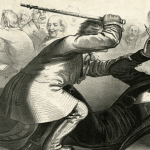 Mysteries
Mysteries  Mysteries
Mysteries  History
History 10 Surprising Stories About the Texas Rangers
 Humans
Humans 10 Philosophers Who Were Driven Mad by Their Own Theories
 Miscellaneous
Miscellaneous 10 Video-Game-Worthy Weapons and Armors from History
 Weird Stuff
Weird Stuff 10 Psychics Who Accurately Predicted Wartime Events
 The Arts
The Arts 10 Pieces of Art Inspired by a Broken Heart
 Health
Health 10 Science Fiction-Sounding New Medical Treatments
 History
History 10 Surprising Facts About the Father of Submarine Warfare
 Space
Space Ten Astonishing New Insights into Alien Worlds
 Weird Stuff
Weird Stuff 10 Bizarre Summer Solstice Rituals Still Practiced Today
 Mysteries
Mysteries Top 10 Haunting Facts About the Ghost Ship MV Alta
 History
History 10 Surprising Stories About the Texas Rangers
 Humans
Humans 10 Philosophers Who Were Driven Mad by Their Own Theories
Who's Behind Listverse?

Jamie Frater
Head Editor
Jamie founded Listverse due to an insatiable desire to share fascinating, obscure, and bizarre facts. He has been a guest speaker on numerous national radio and television stations and is a five time published author.
More About Us Miscellaneous
Miscellaneous 10 Video-Game-Worthy Weapons and Armors from History
 Weird Stuff
Weird Stuff 10 Psychics Who Accurately Predicted Wartime Events
 The Arts
The Arts 10 Pieces of Art Inspired by a Broken Heart
 Health
Health 10 Science Fiction-Sounding New Medical Treatments
 History
History 10 Surprising Facts About the Father of Submarine Warfare
 Space
Space Ten Astonishing New Insights into Alien Worlds
 Weird Stuff
Weird Stuff 10 Bizarre Summer Solstice Rituals Still Practiced Today
10 of the Worst Moms in American History
The expression “as American as mom and apple pie” has painted a picture of nostalgic wholesomeness since its first usage during World War Two. And each May, we celebrate our mothers and their contribution to our lives. But while most of them are angels of wisdom and compassion, there have been a few notorious moms in U.S. history that never earned such wings.
While not all of these women were evil murderers, they do represent someone I am sure we’d all not want to claim as our mom. And their stories just beg to be told…at least as examples of how not to receive that highly coveted “Mother of the Year Award.”
Related: 10 Real-Life Evil Stepmothers That Will Horrify You
10 Alice Bishop (c. 1620–1648)

Photo credit: Wikimedia Commons
During the 17th century, life was hard for colonial women, who were expected to perform laborious household chores starting at the break of dawn while under the complete control of their fathers or husbands. And punishments were harsh for women who committed adultery, especially with a Native American. In the early 1600s, there was a slew of hangings of young mothers who committed infanticide to escape such scandal. However, the trial of Alice Bishop of Plymouth Colony stands out as unique in many ways. She had not committed adultery…with anyone.
Alice became a young widow with two small children, Abigail and newborn Martha, when her husband George died from an unknown cause in 1644. A few months later, her last name changed to Bishop when she remarried, short bereavements being the norm in those days. Two years later, her third daughter, Damaris, was born. On July 22, 1648, a neighbor named Rachel dropped by for a visit, during which she noticed that four-year-old Martha was still asleep on her bed during the day. Abigail handed her friend a kettle and sent her away to borrow buttermilk. When Rachel returned a short while later, her friend seemed morose, and there was a trail of blood on a ladder leading to the attic where little Martha would be found, her throat cut crosswise by a knife. Alice confessed to the crime but did not explain her actions.
To this day, almost 400 years later, nobody knows for sure why Alice Bishop murdered young Martha. However, a common theory is that she suffered from severe postpartum depression. Author Donna A. Watkins, a descendant of the Bishops, further speculates that Alice’s visitor, Rachel, might have made a snide comment about the young girl still being in bed. This might have been the last straw that sent the overworked and exhausted Pilgrim woman over the edge.
What historians do know, however, is that Alice Bishop attended the Duxbury Fair in the autumn of 1648, where she was publicly hanged for her crime.[1]
9 Mary Ball Washington (1708–1789)
As a single parent, George Washington’s mom had significant and positive input in his upbringing, teaching him and his siblings the importance of hard work and perseverance. George’s father, Augustine, died when he was eleven. Despite the fact that his mother, Mary Ball Washington, lost more than half of her late husband’s estate to his sons from a previous marriage, she managed to keep a roof over her family’s heads. And most certainly, the strong religious beliefs she shared with them were a source of strength for her children as they approached adulthood. But as George, her eldest child destined to become the very first U.S. president, grew up and started to spread his wings, his mother grew very possessive of him—to the point she often publicly embarrassed him.
At the age of fifteen, George chose to join the British navy. However, his mother forbade it, an act that generated a general air of disapproval regarding Mary Washington from influential men of the day. George would eventually move to his late father’s property at Mount Vernon in his early twenties. But when he attempted to join General Edward Braddock’s campaign against the French in 1755, his mother hurriedly arrived at his home to vehemently dispel such notions. How embarrassing it must have been for such an eager young man to have to write to his military superiors explaining that his delayed arrival was due to his mother throwing a hissy.
Beyond his embarrassment, George was also financially frustrated. His mother, per her late husband’s will, should have turned over the family property, Ferry Farm, to him when he turned 21, but she had outright refused to surrender it and was keeping all proceeds from the enterprise. Yet George consistently received financial entreaties from her to the point that he found it difficult to pay both his own bills and hers for a property from which he should have been receiving income.
It was hard for Mary Washington during the Revolutionary War years, with her son so far away and out of her needy grasp, even though he had bought her a house in Fredericksburg in which to enjoy her twilight years. Consequently, the crowning moment of George’s embarrassment due to his mother must have been when, in 1781, he was informed that she’d petitioned the Virginia legislature to be declared indigent and made a pensioner of the state. How humiliating it must have been for the proud general to learn that his mother had just applied for public assistance!
Due to his mother’s incessant pleas for money from him (although she was much more well off than most people of the day), George defended himself many times against rumors that he was neglecting her. Mary Ball Washington died of cancer in 1789. Even after her death, George often felt the need to insist that he’d been a good and supportive son to his mother against talk to the contrary.[2]
8 Martha “Calamity” Jane Cannary (1852–1903)
Despite a couple of unsubstantiated claims, there have been two actual, verified accounts of that notorious sharpshooting frontierswoman Calamity Jane giving birth—first to a son and then to a daughter. And to her credit, it’s been said that she tried to be a good mother. Nevertheless, her lifestyle was that of a transient, crossdressing hooligan, taking jobs such as cook, dance-hall girl, ox-team driver, professional scout, wild west performer, brothel worker, prospector, and smallpox nurse. Though when she was off-duty (and quite often not), she had a side career of drinking, brawling, and waking up in jail. It was not a lifestyle conducive to raising kids by any means.
According to newspapers, Calamity Jane, who was rapidly becoming a household name due to her exploits, bore a son she called “Little Calamity” in 1882 while shacked up with a rancher near Miles City, Montana. She was said to have bestowed much love and kisses upon the little guy, but shortly after his birth, Jane started telling people that he had died. End of story, for Little Calamity at least.
In 1887, Jane appeared before a judge in Cheyenne, Wyoming, on charges of public drunkenness, where she offered the court a doctor’s written attestation that she was “in a rather delicate condition” (knocked up). Her daughter Jessie was born four months later, her father being a Texan by the name of Clinton Burke, with whom Jane stuck with for a while. But Jane couldn’t be bolted down, and soon she was seen here and there drunkenly traversing the west dragging her daughter with her. It was noted in 1893 that she was running a restaurant in Castle City, Montana, where she left her daughter alone one night while locked up in a jail cell 200 miles away for drunkenness. And later that same year, when she was seen traveling with Jesse through Rawlings, Wyoming, it was assumed by a local newspaper reporter that, due to her reputation, the girl had been stolen.
Possibly the most comical tale of Jesse’s poor upbringing was in 1895, when Jane implored the community of Deadwood, South Dakota, to help her raise money to send her daughter to a convent school. Well, most certainly, everyone stepped up to the plate, and Jane actually raised a bundle, which she later that night blew on a drunken victory party with her friends. And probably the least amusing tale would be when, after finally finding Jesse placement in a school for a few weeks, Jane found out that other students were mocking and throwing stones at her because of who her mother was.
By the time Jane died in 1903 from inflammatory bowel disease and pneumonia in Terry, South Dakota, looking tired, worn, and twenty years older than her actual age of 53, her daughter had already married. And mother and daughter were officially estranged. And that estrangement must have affected Jesse’s memory. During the 1930s, she was known to refer to Jane as her grandmother, and a decade later, she claimed she was her aunt. But whatever Jesse might have thought of her mother, to the rest of the world, Calamity Jane was the stuff of legend and a colorful icon of the Old West.[3]
7 Kate “Ma” Barker (1873–1935)
Everyone’s heard of Ma Barker and her boys, who comprised most of the Barker-Karpis gang, which terrorized the Midwest and beyond during the early 1930s. Barker was not a mother who pushed education, employment, or even manners upon her four sons. However, they were well-versed in bank robbing, kidnapping, and murder. They also managed to garner quite a lot of fame in American folklore, especially the mother, but both Hollywood and J. Edgar Hoover played a large part in that.
Various renditions of the Barkers’ exploits have been the subject of many television shows and movies, often with the last name changed to something similar. As early as 1940, a mere five years after Barker’s death, Blanche Yurka starred as “Ma Webster,” a mother who ruled her clan of criminals with an iron fist in the movie Queen of the Mob. We’ve had “Ma Jarrett” (White Heat, 1949), “Ma Gantry” (the first episode of The Manhunter, 1974), and even “Mama Fratelli” in The Goonies (1985). Actress Jean Harvey played her three separate times during the ’50s, the same decade that Eliot Ness (played by Robert Stack) goes up against her in an episode of The Untouchables.
Shelly Winters starred in the 1970 cult classic Bloody Mama, though really she was just reprising her 1966 role of “Ma Parker,” one of Batman’s campy TV villains and friend of Catwoman. An animated “Ma Parker” would go on to appear in the Cartoon Network’s Batman: The Brave and the Bold in 2009, which was only fitting as Walt Disney Television already had a “Ma Beagle” harassing Huey, Dewey, and Louie in the cartoon DuckTales.
Interestingly enough, people who knew the woman claim that Kate Barker (sometimes called Arizona or Arrie Barker) had no criminal inclinations. She really just went along for the ride with the guys. Historians generally consider Ma Barker to have been a mere accomplice and caretaker of the boys, and her presence lent an air of family normalcy as they traveled from town to town. This was even corroborated by Alvin Karpis, the actual leader of the gang though of no relation to Kate, who reminded everyone in his memoirs that not once had the authorities ever taken a police photo or set of fingerprints from her. And Harvey Bailey, a bank robber who knew them, claimed that Kate was much too simple-minded to even plan breakfast, let alone lead a gang of criminals!
So how did the woman get such a bad rep? Many people attribute that to J. Edgar Hoover, whose fledgling FBI agents in 1935 gunned down an elderly Ma and her son, Fred, while holed up in Ocklawaha, Florida. There was little to no evidence that the woman had been an active participant in the hours-long shootout that preceded their deaths. The common belief is that Hoover shortly afterward began describing Ma Barker as sinister to cover his backside, calling her “the most vicious, dangerous, and resourceful criminal brain of the last decade.” And just five short years later, the first Barker-inspired movie was released, firmly setting in stone that iron-fist reputation.[4]
6 Eleanor Roosevelt (1884–1962)
There have been few women in American history as profound as Eleanor Roosevelt, who served as First Lady of New York from 1929 through 1932, and First Lady of the United States from 1933 through 1945. She later became active in the United Nations Commission on Human Rights and the Presidential Commission on the Status of Women for JFK. But despite all those achievements and many others, she frequently confessed to being ill-suited to motherhood. As a matter of fact, it’s common knowledge amongst historians that she wasn’t a particularly good mom. Though, they’d be the first to also tell you she came from a long line of parental dysfunction.
Eleanor was born into New York high society, being the niece of Teddy Roosevelt. But from the start, she seemed to lack the beauty and grace such a lifestyle demanded. Her mother, Anna Rebecca Hall Roosevelt, was embarrassed by her plain-Jane looks and often spoke of it right in front of her, referring to her at a young age as “Granny” due to her serious nature. Anna died from diphtheria when Eleanor was only eight years old. Since her father, Elliott, was an unbalanced alcoholic, she was sent off to live with her maternal grandmother, Mary, a rather strict woman who summered at the family home in Tivoli, New York. Unfortunately, the house in Tivoli included two wild, drunken uncles, one of whom liked to shoot at the neighbors. When this became enough of a safety concern for a teenage Eleanor, she was sent off to a private finishing school in London.
After becoming engaged to Franklin Delano Roosevelt (a distant cousin) in 1903, Eleanor then began to have problems with her mother-in-law, Sara Ann Delano, who disliked her and discouraged the marriage. Sara was very controlling and possessive of her son, so after the young couple married, she bought them a townhouse in New York City. It was a nice gesture, but unfortunately, it was adjacent to her own townhouse, with connecting sliding doors on each floor through which she could barge in whenever she pleased. Sara took charge of both households, picking out the furnishings, hiring the servants, firing the servants, and, when the grandkids came along, she took control of their mothering. She also demanded that Eleanor discontinue the inner-city social work she was involved in, which made little sense as she certainly wasn’t needed at home. Sara was even known to have told her grandchildren, “Your mother only bore you; I am more your mother than your mother is.”
Many might argue, though, that the grandmother’s interference was best for the kids. Franklin and Eleanor had five children, and from the start, she felt uncomfortable as a mother. Eleanor had never been taught by example how to be a good mom and often became oddly inventive, like when she attempted to wean her kids from thumb sucking by tying their thumbs down or when she gave one of her infants some air by hanging his cradle out of a window. And any confidence she might have developed was stricken down when her third son, Franklin Jr., a sickly baby, died at the tender age of seven months. Eleanor once wrote: “It did not come naturally to me to understand little children or to enjoy them.” She also wrote: “Franklin’s children were more my mother-in-law’s children than they were mine.”
In 1918, Eleanor discovered that her husband was having an affair with her social secretary and was considering leaving her. Divorce loomed on the horizon, but once again, Grandma Sara stepped in and threatened to disinherit them if they did so. Eleanor played along, but she returned to her social work outside of the home as she seemed to have little input there. This led to the many opportunities for activism and administrative achievements in her life, such as promoting civil rights, visiting impoverished coal miners, and serving as a delegate to the United Nations. She was said to regret her feelings of insecurity as a mother, though, often to the point of depression. However, her grandchildren in later years described her to be a warm and loving grandma. Truly…all’s well that ends well.[5]
5 Ethel Marion Milne (1893–1953)
Ethel Marion Milne of Grand Rapids, Minnesota, was a frustrated vaudevillian turned housewife when she became pregnant for the third time in 1921. She had an unhappy marriage with her husband, Frank Gumm, who seemed more interested in spending time with younger men than with her, so she almost terminated the pregnancy. However, a friend of her husband’s in medical school advised her that not only was abortion illegal, but it was also dangerous. Thus, Frances Ethel Gumm was born on June 10, 1922, the youngest of three girls, into an unloving household.
Soon after, Ethel began to live vicariously through her daughters. She had them performing on stage in Grand Rapids as the Gumm Sisters when Frances was only two and a half years old. The Gumms lived in a toxic household, and Frances would later say that the only time she felt wanted was when she was singing. Her father’s extramarital behavior would worsen to the point that her mother felt the need to move the family out of state. They settled in the Los Angeles area, where Ethel began showcasing her daughters at venues, some of which were inappropriate for children, such as the famous Cocoanut Grove nightclub on Wilshire Boulevard. Often when Frances was feeling ill, her mother would threaten to hurt her if she didn’t perform. By the time she had turned ten, Ethel had begun plying her with pills, some to keep her moving, others to make her sleep.
Frances really outshone her sisters when it came to talent, and by the time she was 13, she’d been signed with MGM, but the studio hated her name and changed it. They borrowed “Garland” optimistically from a noted film critic, and “Judy” was a popular song of the day. But that wasn’t all they called her. Louis B. Mayer referred to her as “my little hunchback,” as Judy suffered from curvature of the spine. Due to her chunkiness, she was put on a strict diet of cottage cheese and chicken broth. But her mother, Ethel, most certainly ate well, as she was the one whom the studio paid.
During the making of The Wizard of Oz, the studio heads encouraged Judy’s use of amphetamines to keep her awake during the long shooting hours. Though, by this time, she was already addicted to them and barbiturates too. Garland claims she was also the subject of sexual harassment while at MGM, and with her father having died at this point, she had nobody to turn to except her mom, who turned a blind eye to everything but the checks the studio sent.
Years later, Garland would refer to her mother, who died in 1953, as “the real Wicked Witch of the West.” The years of popping pills that Ethel had initiated upon her led to life-long addiction issues, which in turn led to several failed marriages, financial problems, and eventually her death in 1969. Judy Garland’s actress daughters, Liza Minnelli and Lorna Luft speak very well of their mother and her loving nature. It’s nice to know the sin of self-centeredness can skip a generation or two…[6]
4 Joan Crawford (c. 1906–1977)
Another pop-cultural icon of bad motherhood is, of course, Joan Crawford, who has been accused of adopting kids for publicity, beating the crap out of them, and screaming almost incoherently “…no wire hangers EV-EEER!” But how much of that story is true? How much of that stupid movie (er…cult classic) actually happened?
More people have probably seen the movie Mommie Dearest than have read the book written by Christina Crawford, Joan Crawford’s adopted daughter, in 1978. Likewise, many people probably aren’t aware that besides her brother, Christopher, there were two other girls in that household. Twins Catherine and Cynthia were adopted in 1947, and they have claimed that their older sister’s story is bull! Both twins are deceased, but they have previously stated that they had no memories of any abusive behavior in the household and described their mother as being a loving parent. They accused their sister of outright lying.
Other people have also claimed Christina is a liar, including Douglas Fairbanks Jr., Joan’s first husband, and actress Myrna Loy, who knew them well. And while Joan’s long-term secretary, Betty Barker, admitted that the actress may have had faults, she said child abuse was not one of them. Even Christina herself acknowledged that the movie strayed too far from her original book and that it was a grotesque work of fiction in which she had no involvement. She was never beaten with a coat hanger, as depicted in the film.
But Christina has held on to her own convictions throughout the years, claiming that her younger sisters hadn’t yet been born when Joan had adopted her and that by the time she was sent away to boarding school, they were only two years old. She insists that just because they didn’t see the abuse does not mean it didn’t happen. She’s also accused other people of ignoring it rather than standing up to her mother, who was known to be headstrong and cruel. Helen Hayes was one of those people. The legendary actress, in her autobiography, corroborates Christina’s allegations that Joan was cruel to her first set of children and that one of the reasons people were hesitant to stand up to her was that they were afraid she’d become enraged and vent her anger on the kids.
Fellow actress and arch-enemy Bette Davis had little good to say about Crawford as well. After Crawford’s death in 1977, Davis was quoted to have spat: “You should never say bad things about the dead, only good. Joan Crawford is dead…good.” But surprise, surprise—Davis’s daughter also wrote a book.[7]
3 Bette Davis (1908–1989)
Bette Davis’s daughter, Barbara “B.D.” Hyman, released her own celebrity tell-all book about her mother in 1985. But unlike Christina Crawford, she did it while the woman was still alive. In My Mother’s Keeper, Hyman alleges a childhood of domestic violence, alcoholic parents, and emotional abuse. Hyman’s book came out when her mother was recovering from a stroke yet overseas filming a movie, and upon her return, Davis was shocked to discover what her daughter had written about her. Much like in the aftermath of Mommie Dearest, friends and family members came forward to defend Davis against Hyman’s claims, many of them furious over the extremely bad timing of the book’s release.
In her book, Hyman painted a picture of physical abuse from Gary Merrill, her stepfather and Davis’s 4th and last husband. She also described her mother as a selfish alcoholic who would fake suicide attempts to punish her children, two of whom she claimed had been adopted simply to be her companions. Davis institutionalized one of her adopted kids, Margot, at the tender age of three. She remained there for most of her life after being diagnosed with brain damage and mental disabilities. Hyman also claimed that Davis pulled her out of school to be her personal assistant when she was just eleven years old!
Gary Merrill was one of the people who came to his ex-wife’s defense, though his testimony wasn’t well delivered. He basically confirmed his stepdaughter’s claims, though calling them exaggerated and “kernels of truth.” He then admitted to having had physical altercations with his family but condoned it all by stating that they did, after all, drink excessively and that his ex-wife, Davis, usually started the brawl. And he actually gave this explanation in a 1985 interview for People magazine, trying to sweep the controversy under the rug. It must have been his first time handling a broom…
But Bette Davis really got even with her daughter for her disloyalty after her death in 1989 when the will was read. Barbara Davis had been left out of it, along with her two children. What’s really odd is that Davis’s mentally disabled daughter, Margot, had also been given the boot for unknown reasons and without any specified means of support. Ouch![8]
2 Marie Noe (1928–2016)
Marie Noe of Philadelphia was a rather odd woman who, between the years 1949 and 1968, suffocated eight of her ten infant children, the other two having died from natural causes. Each of these deaths was attributed to SIDS (sudden infant death syndrome). Since her husband, Arthur, believed her innocence, the authorities simply played along. Thirty years would pass before a local publication, the Philadelphia magazine, ran an article called “Cradle to Grave” in 1998 questioning the Noes’ innocence. The author of the piece, Stephen Fried, not only interviewed the Noes but also spoke with police officers who quietly reopened the case.
Marie was brought in for questioning the same day Fried’s article ran. During twelve hours of interrogation, she admitted smothering four of her babies. However, she claimed she was uncertain how the other four died. As to the very first murder, she stated: “He was always crying. He couldn’t tell me what was bothering him. He just kept crying… I took my hand and pressed his face down into the pillow until he stopped moving.” Marie pled guilty to eight counts of 2nd-degree murder, which made for the biggest case of maternal infanticide in history. Yet, she never spent one day inside of a jail cell up until her death in 2016.
Wait, what?
Marie was 71 years old at the time of her arrest, and she was offered a rather unusual plea agreement wherein she’d stay out of prison as long as she allowed a team of experts from around the globe to pick her brain, trying to discover what exactly makes women like her tick. This plea agreement was unprecedented, and instead of incarceration, she was to receive 20 years probation serving the first five under house arrest. Of course, she’d have to be a fool (and not just a murdering maniac) not to jump at the offer.
But as she was willing to undergo widespread psychiatric examination, the controversial study never took place beyond a diagnosis of mixed-personality disorder (ya think?). Though, some form of developmental disorder and alcoholism also appear in her medical records. As the original author of “Cradle to Grave” has stated, Marie got to sit at home watching TV with her husband for the next decade or so, which is what she’d been doing for years anyhow, despite the fact she had broken her probation early on when she ate at a Denny’s restaurant.
Arthur Noe died in 2009 after years of defending his wife’s innocence. Marie died in a nursing home in 2016, the year her firstborn would have turned 67 if she hadn’t smothered him as a baby.[9]
1 Lenore Skenazy (1959–)
Columnist Lenore Skenazy made headlines and outraged parents when, in 2008, she published an article in the now-defunct New York Sun called “Why I Let My 9-Year-Old Ride the Subway Alone,” an admission that would inspire the formation of the Free-Range Kids movement. She allowed her son, Izzy, to ride the New York subway unsupervised because she felt he was ready for it and that there was no real danger. She believes that it is wrong to teach modern-day children that they are in constant danger whenever they go outside. She feels overprotective parents should loosen the reins and let their kids play outdoors without supervision, a philosophy that earned her the nickname “America’s Worst Mom.”
Many people called her an abusive parent, and some accused her of being insane. A few people even said they wish Izzy had had a bad experience in order to teach her a lesson. But Skenazy also had supporters, and between the two camps, there was much debate. And this debate was featured on just about every news and talk show on TV and in every newspaper across the U.S. and abroad.
Skenazy rode this controversy for years with great success. In 2009, she published Free-Range Kids, an extension of her blog and a best seller on its own. A year later, she organized the first annual “Take Our Children to the Park & Leave Them There Day.” In 2012, she hosted World’s Worst Mom, a reality TV show, and in 2017, she co-founded the Let Grow organization, which partners with schools promoting her agenda. Skenazy lectures worldwide, and in 2018, the state of Utah passed the Free-Range Parenting bill, which assures parents that giving their kids a little freedom won’t backfire with charges of neglect.
But despite all the debate, people still find it odd to see a pre-teen child commuting on public transportation unescorted, especially in a big city. Skenazy admits that the authorities have contacted her three times due to Izzy’s solo trips. Twice, shortly after her first controversial column appeared in 2008, the police called to make sure she knew of her son’s whereabouts. The third time it happened was at Port Authority when Izzy was 15, and the police thought perhaps he might be a runaway. Skenazy also admits that she was grateful for the call and is thankful that the police are trying to look after homeless teens. Perhaps the term “America’s Worst Mom” is a bit extreme…[10]








